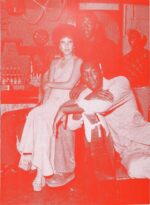Life in Philly de Mao Ishikawa illustre bien ses expériences lors de sa visite en ville en 1986. En visitant Myron Carr, un ancien soldat américain que Ishikawa avait rencontré alors qu’elle travaillait dans un bar près d’une base militaire américaine à Okinawa en 1975, Ishikawa s’est retrouvée dans la communauté afro-américaine de Philadelphie ; elle a vécu au centre-ville de Philadelphie dans sa forme la plus brute. Les images qui en résultent dépeignent ceux qu’elle a rencontrés, simplement sans gêne et naturellement ; la publication comprend un texte de Keiichi Takeuchi, Shomei Tomastu et Keisuke Sugiura. Les textes sont disponibles en japonais et en anglais, photos en n.b.
« The city’s origins began with the construction of a residential area by Wiliam Penn, who corss to America with his fellow Quakers. Penn named the area « Philidelphisa », hwich is ancient Greek for the « city of brohtherly love » (philos means love; adelphos means brothers, and is a suffix attached to city names). This series of photographs was taken by Mao Ishikawa. They are of Philadelphia as she saw it in 1986. They share something in common with the origins of the city’s name. The subjects of her photographs and their families accept her as she is, a lone photographer visiting from a far-off island. Here all their humanity is revealed, her photos either capturing the mundane routine of daily life, the partying, husbands and wives squabbling, or having sex. » – Keiichi Takeuchi excerpt from Keiichi Takeuchi’s essay for Life in Philly entitled Spirit of Philly.
Mao Ishikawa’s Life in Philly vividly captures her experiences during her visit to the city in 1986. Visiting Myron Carr, an ex U.S Soldier whom Ishikawa had met whilst working at a bar near a U.S army base back in Okinawa in 1975, Ishikawa found herself living within the African American community of Philly; experiences downtown Philly in its rawest form. The resulting images depict those with whom she had encountered, entirely unabashed and natural. Included within the publication is text by Keiichi Takeuchi, Shomei Tomastu and Keisuke Sugiura. The texts is available in both Japanese and English.












